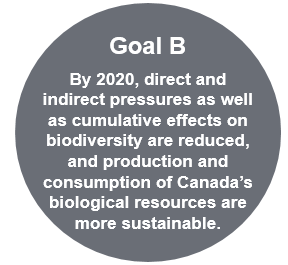Canada Target 7. By 2020, agricultural working landscapes provide a stable or improved level of biodiversity and habitat capacity.
About the Target
Agriculture interacts both positively and negatively with biodiversity and with the capacity of the landscape to support habitat. Conversion of natural areas to agricultural land causes a decline in wildlife habitat capacity through, for example, wetland drainage, natural land cultivation, loss of grasslands, overgrazing, and fragmentation or loss of forest cover. However, agricultural landscapes also include wooded areas, wetlands, shorelines, natural pastures, and other features which are important wildlife habitats. In addition, management practices such as conservation tillage, shelterbelt planting, responsible grazing, and watercourse buffers can support the land in producing food, fuel and fibre while maintaining habitat capacity and sustaining biodiversity.
Efforts to maintain and improve biodiversity on agricultural lands help to sustain natural systems and wildlife habitat while supporting agricultural production. Biodiversity provides ecosystem services, such as nutrient cycling, soil formation, water purification and pollination, which are essential to agriculture and improve its capacity to recover and adapt to environmental stresses such as drought.
Canada Target 7 is linked with the following global Aichi target under the United Nations Convention on Biological Diversity Strategic Plan for Biodiversity 2011-2020:
Aichi Target 5 - By 2020, the rate of loss of all natural habitats, including forests, is at least halved and where feasible brought close to zero, and degradation and fragmentation is significantly reduced.
Aichi Target 7 - By 2020 areas under agriculture, aquaculture and forestry are managed sustainably, ensuring conservation of biodiversity.
2020 Final Assessment
Between 2011 and 2017, there was little change in the wildlife habitat capacity on agricultural land. Where it did change, it increased on a slightly larger area (3.4% of agricultural land) than where it decreased (3.1% of area). Increases occurred in the western prairies in areas where crops shifted from grain production to pastures and hay, which support more wildlife species for breeding and feeding. Declines occurred in the eastern prairies, with a shift from pasture and hayland to annual crops. In eastern Canada, declines primarily occurred along the St. Lawrence Lowlands, where agricultural fields expanded, and natural and semi-natural cover was lost. An update of the wildlife habitat capacity to 2020 is not yet available.
Sustainable agriculture that supports biodiversity is promoted within federal-provincial/territorial cost-shared Environmental Farm Plan (EFP) programs, delivered by provinces and the Yukon. The EFP is a voluntary tool designed to help farmers assess on-farm environmental risks, including risks to biodiversity, and develop an action plan detailing the beneficial management practices (BMPs) required to mitigate these risks and support continuous improvement. Opportunities to manage, conserve and restore wildlife habitat on agricultural land, and other BMPs that support biodiversity, are included within the program. As of 2017, 40% of farms in Canada had an EFP, while 7% were developing one.[i] Based on such available information, the target has been partially met.
[i] Statistics Canada (2019) Table 32-10-0205-01 Farms with a formal Environmental Farm Plan
Contributing Actions
Federal, provincial and territorial governments are committed to redoubling efforts to conserve Canada’s biodiversity as outlined in the Pan-Canadian approach to transforming species at risk conservation in Canada. The pan-Canadian approach includes agriculture as a priority sector. Part of the work includes the development of an agriculture sector Conservation Action Plan for Biodiversity and Species at Risk.
Species at Risk Partnerships on Agricultural Lands (SARPAL) is an initiative dedicated to working with farmers to support the management and recovery of species at risk on agricultural land. Provinces and territories continue to develop projects with the support of this program.
One project stemming from the SARPAL program was the development of a Habitat & Biodiversity Assessment Tool in Alberta to help farmers enhance and maintain habitats for species at risk through the EFP process. The goal is for Alberta producers to know which potential species at risk they may have on their land and how to make simple changes that will conserve them and their habitats. Other provinces are working to adapt the tool for use in other regions. The Canadian Agricultural Partnership includes up to $438 million in cost-shared programs between the federal and provincial/territorial governments that are designed to raise producers’ awareness of environmental risks, including through development of EFPs, and to accelerate the adoption of on-farm technologies to reduce these risks, including to restore and enhance wildlife habitat on agricultural lands.
The Agricultural Climate Solutions (ACS) program supports the adoption of agricultural practices, such as shelterbelts or cover crops that reduce greenhouse gas emissions and lead to carbon storage on farmland. These practices can also be beneficial to biodiversity. ACS is a program under the more than $4 billion Natural Climate Solutions Fund.
Bee Friendly Farming (BFF) is a certification program from Pollinator Partnership working with farmers to help protect, preserve and promote pollinator health. BFF provides guidelines for farmers to promote pollinator health on their lands. The program is overseen by a task force of experts from the North American Pollinator Protection Campaign (NAPPC) including scientists and farmers, as it strives to set standards for sustainable farming on important concepts like planting pollinator food resources, providing nesting habitat, and incorporating an integrated pest management strategy. BFF helps ensure the future of both pollinators and sustainable agriculture as it expands across North America and around the globe.

